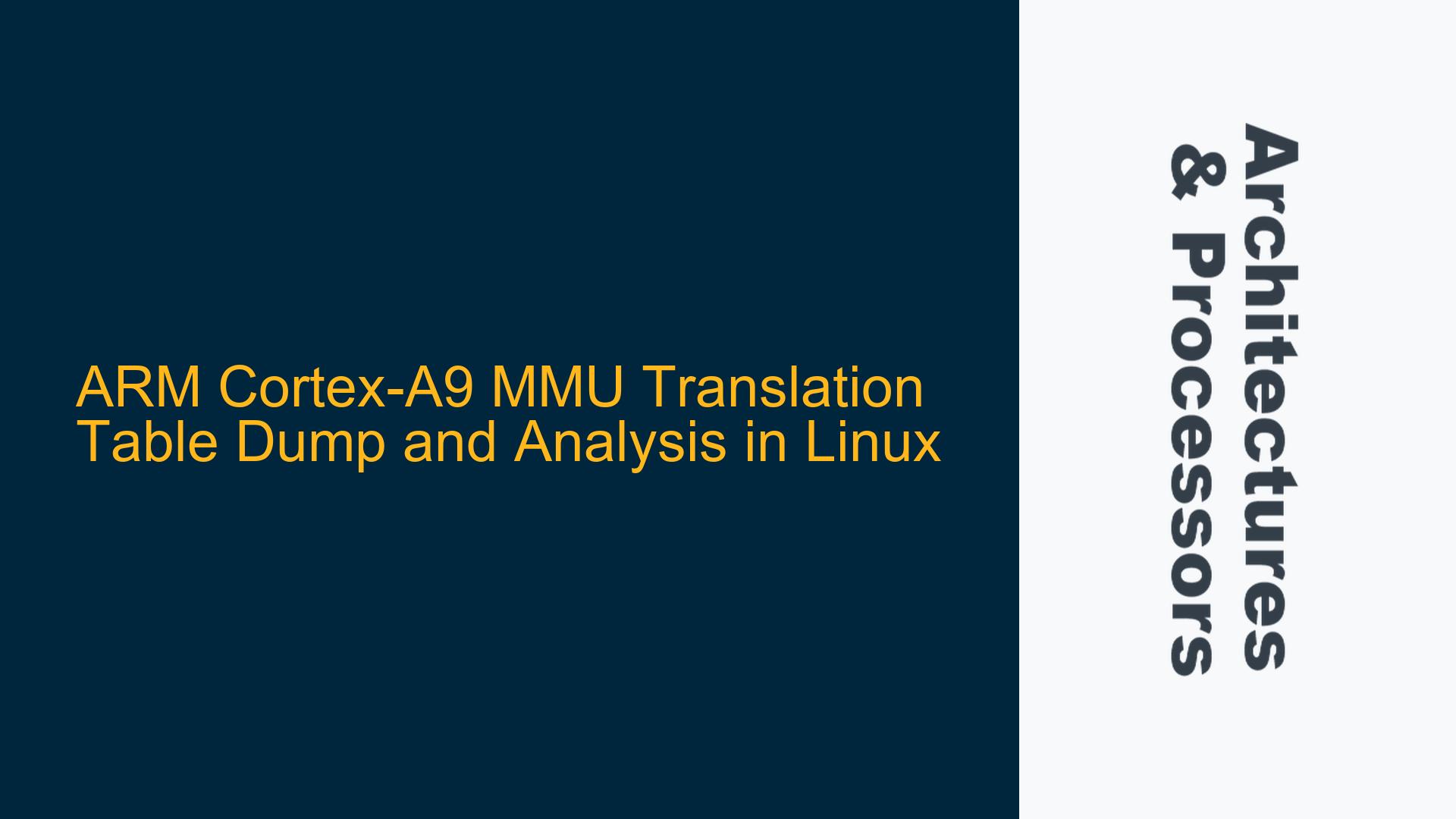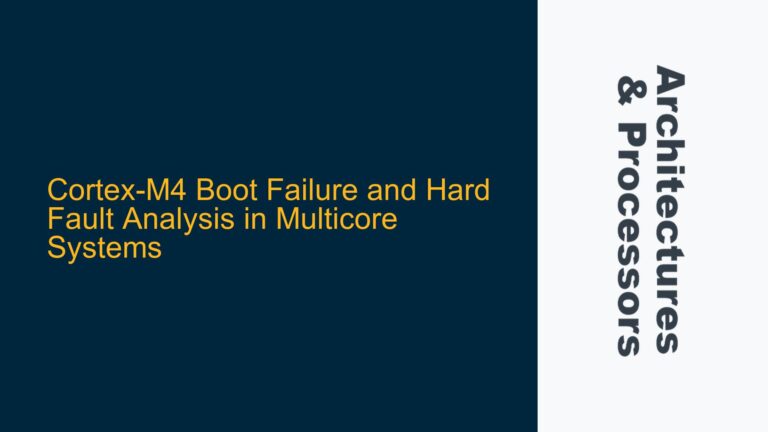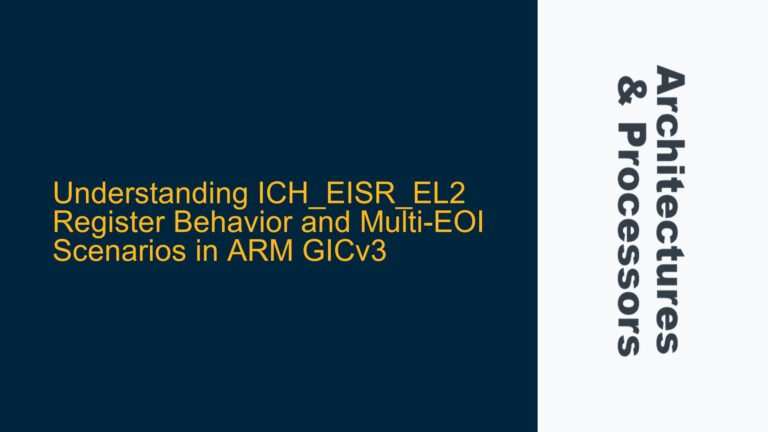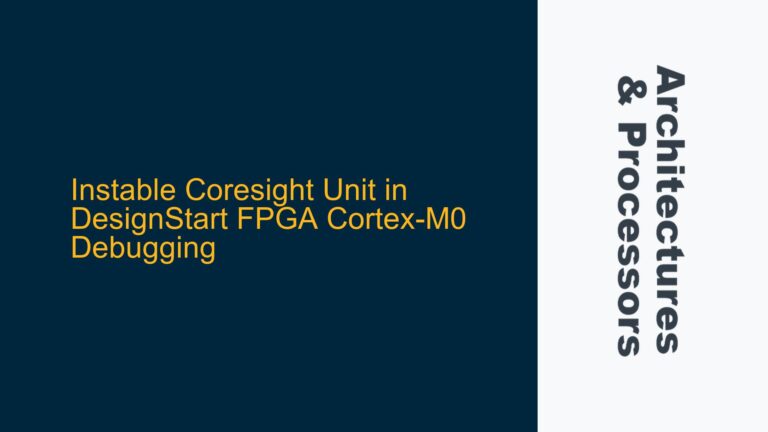ARM Cortex-A9 MMU Translation Table Access and Interpretation
The ARM Cortex-A9 processor, like many ARM cores, utilizes a Memory Management Unit (MMU) to handle virtual-to-physical address translation. The MMU relies on translation tables, which are hierarchical data structures stored in memory, to perform this translation. In Linux, the MMU translation tables are managed by the kernel, but there are scenarios where developers may need to directly access or dump these tables for debugging, performance analysis, or low-level system optimization. This post delves into the intricacies of accessing and interpreting the MMU translation tables on an ARM Cortex-A9 processor running Linux, focusing on the hardware and software interfaces involved.
The ARM Cortex-A9 MMU supports two translation table base registers (TTBR0 and TTBR1), which point to the base of the translation tables for two distinct address ranges. TTBR0 typically covers the lower address space (user space), while TTBR1 covers the higher address space (kernel space). Understanding how to access these registers and interpret their contents is crucial for diagnosing issues related to memory management, such as page faults, incorrect memory mappings, or performance bottlenecks caused by inefficient translation table walks.
Challenges in Accessing CP15 Registers and Translation Table Offsets
Accessing the MMU translation tables on an ARM Cortex-A9 processor involves interacting with the CP15 system control coprocessor, which manages critical system configurations, including the MMU. The CP15 registers, such as TTBR0 and TTBR1, are not memory-mapped but are instead accessed via specific coprocessor instructions. This presents a challenge for developers who are accustomed to working with memory-mapped registers or higher-level abstractions provided by operating systems like Linux.
One of the primary difficulties lies in determining the correct offsets and procedures for reading the CP15 registers. The ARM Architecture Reference Manual provides detailed information about the CP15 registers, but navigating this documentation can be daunting due to its complexity and the sheer volume of information. Additionally, the Linux kernel abstracts much of the low-level hardware interaction, making it non-trivial to directly access these registers from user space or even kernel space without modifying the kernel itself.
Another challenge is the distinction between the hardware translation tables and the software-managed page tables maintained by the Linux kernel. While the hardware translation tables are directly used by the MMU for address translation, the Linux kernel maintains its own page tables to manage memory mappings for processes, memory allocation, and other high-level operations. These software page tables are periodically synchronized with the hardware translation tables, but discrepancies can arise, especially during context switches or dynamic memory allocation.
Techniques for Dumping and Analyzing MMU Translation Tables
To dump and analyze the MMU translation tables on an ARM Cortex-A9 processor, developers must employ a combination of low-level hardware access techniques and kernel debugging tools. The following steps outline a comprehensive approach to achieving this:
Accessing CP15 Registers via Kernel Modules
Since the CP15 registers are not directly accessible from user space, developers must write a kernel module to interact with these registers. The kernel module can use inline assembly or kernel APIs to execute the necessary coprocessor instructions for reading TTBR0 and TTBR1. For example, the following code snippet demonstrates how to read TTBR0 using inline assembly in a kernel module:
#include <linux/module.h>
#include <linux/kernel.h>
static uint32_t read_ttbr0(void) {
uint32_t ttbr0;
__asm__ volatile("mrc p15, 0, %0, c2, c0, 0" : "=r" (ttbr0));
return ttbr0;
}
static int __init mmu_dump_init(void) {
uint32_t ttbr0 = read_ttbr0();
printk(KERN_INFO "TTBR0: 0x%08x\n", ttbr0);
return 0;
}
static void __exit mmu_dump_exit(void) {
printk(KERN_INFO "MMU dump module unloaded\n");
}
module_init(mmu_dump_init);
module_exit(mmu_dump_exit);
MODULE_LICENSE("GPL");
This kernel module reads the value of TTBR0 and prints it to the kernel log. Similar techniques can be used to read TTBR1 and other CP15 registers.
Parsing the Translation Table Base Address
The value read from TTBR0 or TTBR1 contains the base address of the translation table, along with additional configuration bits. The base address is typically aligned to a 16 KB boundary, and the lower bits of the register contain flags related to the translation table walk, such as the cacheability and shareability attributes. To extract the base address, developers must mask out the lower bits. For example:
uint32_t ttbr0 = read_ttbr0();
uint32_t base_address = ttbr0 & 0xFFFFC000;
Walking the Translation Tables
Once the base address of the translation table is obtained, developers can walk the table to retrieve the individual page table entries (PTEs). The ARM Cortex-A9 MMU uses a two-level translation table scheme for 4 KB pages. The first level, known as the page directory, contains entries that point to second-level page tables. Each second-level page table contains entries that map virtual addresses to physical addresses.
To walk the translation tables, developers must follow these steps:
- Extract the page directory index (PDI) from the virtual address. The PDI is used to index into the page directory and retrieve the base address of the second-level page table.
- Extract the page table index (PTI) from the virtual address. The PTI is used to index into the second-level page table and retrieve the PTE.
- Extract the physical address and attributes from the PTE.
The following code snippet demonstrates how to perform a translation table walk:
uint32_t translate_address(uint32_t virtual_address, uint32_t ttbr0) {
uint32_t base_address = ttbr0 & 0xFFFFC000;
uint32_t pdi = (virtual_address >> 20) & 0xFFF;
uint32_t pte1 = *(uint32_t *)(base_address + pdi * 4);
if ((pte1 & 0x3) == 0) {
printk(KERN_ERR "Page directory entry not valid\n");
return 0;
}
uint32_t second_level_base = pte1 & 0xFFFFFC00;
uint32_t pti = (virtual_address >> 12) & 0xFF;
uint32_t pte2 = *(uint32_t *)(second_level_base + pti * 4);
if ((pte2 & 0x3) == 0) {
printk(KERN_ERR "Page table entry not valid\n");
return 0;
}
uint32_t physical_address = (pte2 & 0xFFFFF000) | (virtual_address & 0xFFF);
return physical_address;
}
Synchronizing Hardware and Software Page Tables
As mentioned earlier, the Linux kernel maintains its own page tables, which are periodically synchronized with the hardware translation tables. To ensure consistency between the hardware and software page tables, developers can use kernel debugging tools such as crash or gdb to inspect the kernel’s page tables. Additionally, the Linux kernel provides functions like virt_to_phys and phys_to_virt to convert between virtual and physical addresses, which can be useful for cross-referencing the hardware translation tables with the kernel’s page tables.
Analyzing Translation Table Entries
Each PTE in the translation tables contains not only the physical address but also attributes that control memory access permissions, cacheability, and shareability. These attributes are crucial for diagnosing issues related to memory protection, cache coherency, and performance. The following table summarizes the key attributes in a PTE:
| Bit Range | Attribute | Description |
|---|---|---|
| 1:0 | Type | Indicates the type of the entry (e.g., invalid, 4 KB page, 64 KB section). |
| 2 | Bufferable | Determines whether writes to the memory region are bufferable. |
| 3 | Cacheable | Determines whether the memory region is cacheable. |
| 4 | Shareable | Determines whether the memory region is shareable between multiple cores. |
| 8:5 | Access Permissions | Controls read/write/execute permissions for the memory region. |
| 11:10 | Domain | Specifies the domain for the memory region (used for access control). |
By analyzing these attributes, developers can identify potential issues such as incorrect memory protection settings, inefficient cache usage, or improper sharing of memory between cores.
Debugging Common Issues
Several common issues can arise when working with MMU translation tables on an ARM Cortex-A9 processor. These include:
-
Page Faults: Page faults occur when the MMU cannot translate a virtual address to a physical address. This can be caused by invalid or missing entries in the translation tables. To diagnose page faults, developers should inspect the faulting virtual address and walk the translation tables to identify the problematic entry.
-
Incorrect Memory Mappings: Incorrect memory mappings can lead to data corruption, crashes, or unexpected behavior. Developers should verify that the physical addresses and attributes in the translation tables match the intended memory layout.
-
Performance Bottlenecks: Inefficient translation table walks can degrade system performance. Developers should optimize the translation tables by minimizing the number of levels in the table hierarchy and ensuring that frequently accessed pages are mapped with cacheable and bufferable attributes.
-
Cache Coherency Issues: Cache coherency issues can arise when multiple cores access shared memory regions with inconsistent cacheability or shareability attributes. Developers should ensure that shared memory regions are marked as shareable and use appropriate cache maintenance operations to maintain coherency.
Conclusion
Accessing and analyzing the MMU translation tables on an ARM Cortex-A9 processor running Linux requires a deep understanding of the hardware and software interfaces involved. By writing kernel modules to access CP15 registers, walking the translation tables, and analyzing the page table entries, developers can diagnose and resolve complex memory management issues. Additionally, synchronizing the hardware and software page tables and debugging common issues such as page faults, incorrect memory mappings, and performance bottlenecks are essential skills for embedded systems engineers working with ARM architectures. With the techniques outlined in this post, developers can gain valuable insights into the inner workings of the MMU and optimize their systems for reliability and performance.





